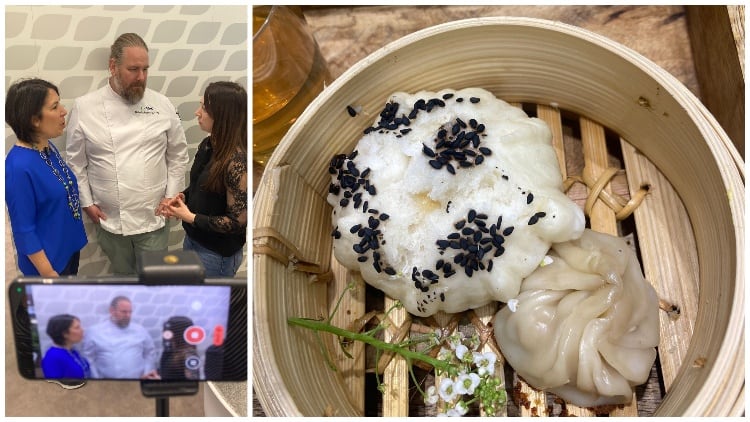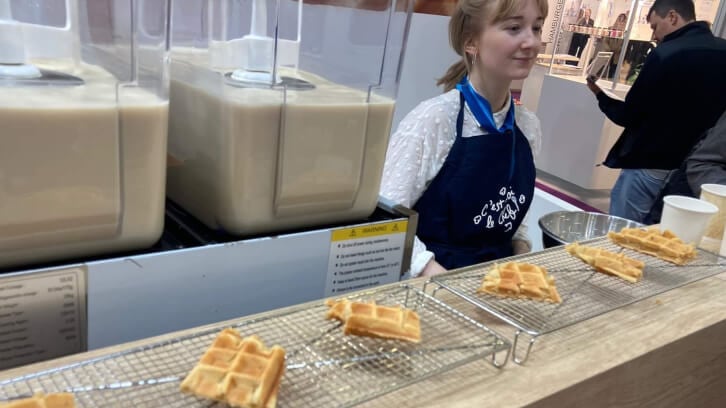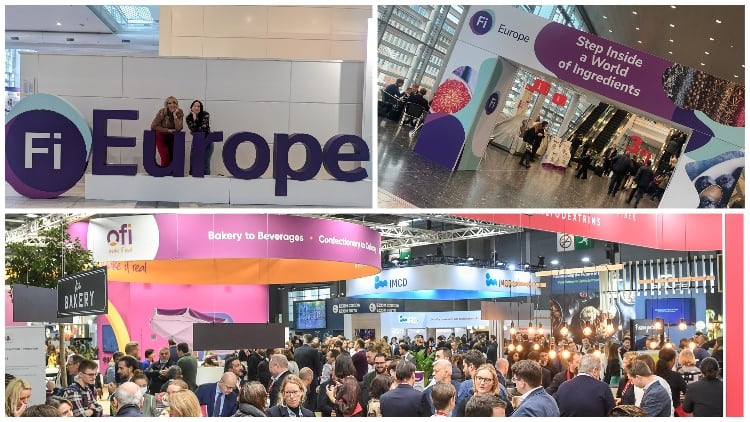Plant-based is here to stay
At Food Ingredients Europe (FiE) 2023, the appetite for plant-based foods remained a key trend among exhibitors.
Whilst the alternative meat category witnessed a sluggish year, consolidation is apparently not an indicator that the end is nigh, but rather a case of survival of the fittest – or tastiest.
“We did see a slowdown in the past year, but I do think it’s something that’s starting to grow again,” Bianca Lefevere, product manager for BENEO – which acquired Meatless B.V. last year – told Food Manufacture. “With any innovation you have this ‘peak innovation time’ when people are jumping onto these new ideas.”
In other words, as things become popular, the competition heats up, before quickly cooling back down again to leave just the top performers.
“Now, in plant-based, we’re in this place where we’re getting out from this ‘dip’,” she continued.
Lefevere said the brand owes its success in plant-based to “knowing the consumer” and that it recognises that these meat-like substitutes are much more geared to those who want to enjoy both categories – i.e. flexitarians.
In response, BENEO has focused on this consumer and expanded its meatless portfolio with the introduction of its meatless mincemeat and meatless beef bites. These contain a combination of pea protein and mycoprotein which offer juiciness and fibre to the product; and come off the back of brand research which found as many as 76% of (European) flexitarians prefer beef-like options.
For ICL Food Specialities (which may be better known as Fibrisol in the UK), alternative proteins remain a focus too.
Reflecting on the evolution of plant-based, its commercial lead for Europe, Jorg Rendel, said that the category had now diversified.
“Before we may have seen very simple copies of cold cuts or nuggets,” he added.
Now, Rendel said that consumer’s expectations have risen – and with that, a demand for new plant-based ventures such as seafood analogues and vegan sauces have emerged.
Jungbunzlauer has also recognised this inclination for novel plant-based products and within its demonstration at the Frankfurt event used plant-based, scrambled eggs as a way of showcasing its texture solutions. As we all know, mimicking meat and dairy alternatives has been notoriously tricky and plant-based egg is no different!
In a formal, live presentation, the Swiss-based company showed how its biogums, TayaGel® and xanthan gum, can support the development of new recipes.
Dairy alternatives is a category performing particularly well and Bunge has recognised this, with its solution ‘Beleaf PlantBetter’ to help mimic the desirable properties of dairy-based butter.
Achieving the precise aeration, volume and taste required for products such as croissants, cakes, etc., has proven challenging for most butter substitutes so far. These challenges have been further amplified by the escalating volatility in butter pricing, driving the need for innovative solutions.
"Beleaf™ PlantBetter is a game-changing innovation developed by Bunge that brings together the sustainability attributes of plant-based with the uncompromising sensory and performance of dairy butter – all while delivering a lower cost-in-use compared to butter," explained Aaron Buettner, president food solutions at Bunge.

ADM agreed choice in plant-based was a key trend. Described in its recent culinary trend report as ‘plant-forward future’, ADM says it is seeing a rise in the flexitarian movement, and with it, demand for more protein options.
The company has also seen growth of “the global palette” and has been experimenting with this within its plant-based offerings, showcasing at its booth tzatziki made with vegan cream and Dim Sum filled with its plant-based ingredients.
Meanwhile, Lallemand Bio-Ingredients was focused on flavour within plant-based, launching Savor-Lyfe CI – part of the Savor-Lyfe series. Notably, this solution excels at imparting a rich and authentic chicken flavour, elevating the taste profile of alternative protein dishes.
High protein and fibre
From the eclectic mix of exhibitors, it was clear to see there is a demand for protein and fibre enriched products, with many of them showcasing this as their key attribute.
At the Prinova booth, guests were greeted with white chocolate matcha flavour plant protein powder which was blended with pea and fava bean protein isolates. This is said to deliver 22g of protein per serving.
This demand for higher protein coincides with the trend for plant-based products, with companies suggesting this as the desirable protein source over animal-based. In fact, Prinova’s research found that as many as 42% of active consumers named plant proteins as one of the ingredients they most looked for in sports nutrition products.
High protein was also high on the agenda for Angel Yeast, which was showcasing its AngeoPro solution at the Germany-based show.
AngeoPro is a 100% naturally fermented yeast protein, with all nine essential amino acids and 80% protein content, as well as being gluten-free.
Alongside bread, which was available at the booth for tasting, this versatile ingredient can also be used to enhance the flavour and nutritional profile of products, such as vegan cheese and meat, protein drinks and bars, as well as dairy applications.
Again, the company saw a demand for alternative proteins, with this yeast protein able to replace its animal or plant-based (such as pea) counterpart.
Jeppe Laursen, head of global sales at Arla Ingredients, meanwhile, noted an “expansion” within the applications of high protein products. Two examples to inspire its customers were a fermented, high protein beverage and a high protein ice cream, with Laursen predicting that the latter will become a particularly popular product type for protein in the new year.
However, he also sees high protein cheese as a strong possibility for 2024. While cheese is high in protein naturally, it has not been highlighted as an attribute – and that may be subject to change.
Speaking with Lactalis’ senior product manager, Elodie Macariou, she concurred the applications for protein were growing. “At the beginning, it was more sports nutrition. Now it’s become mainstream.”
Indeed, it was pretty much unanimous that protein will emerge in new forms next year.
However, for AB Enzymes, the big focus for food manufacturers catering to western societies should be plugging the fibre gap. The company is now in the pre-launch process of an enzyme solution that can reduce sugar whilst increasing fibre in fruit- and vegetable-based products.
“The consumer don’t have a protein gap, but there is a real fibre gap – and we see a lot of increasing demand for fibres from different sources and different types of fibres, such as soluble.”
According to data from the Food and Drink Federation, just 9% of adults in the UK meet the recommended amount of fibre.
While the UK Government has increased its fibre dietary recommendations (back in 2015) from 24g to 30g a day, little has been done to help get fibre into British diets. Rather, the focus has been much more on sugar, with fat and salt getting the tail end of the attention (and most likely only as a result of the HFSS rule) and fibre trailing far behind.
When it comes to reformulation, there has arguably not been enough attention centred on calorific content either. Whilst we need to reduce levels of sugar and companies have done well in this feat, have these alterations impacted calories? With the UK in the grip of an obesity crisis, this would surely be a worthwhile exploration.
The calorie content was something AB Enzymes had paid attention to in its reformulation journey, with the demo smoothie on its booth having more fibre and less sugar but also a lower calorie count.
Local sourcing and transparency
With food production, packaging and distribution responsible for a third of all greenhouse gas emissions and up to 80% of global biodiversity loss, there has been a push towards localised supply chains and increased transparency on the inner workings of companies and how they will be reducing their environmental impact.
The below graph from YouGov illustrates this well, with Italian consumers most enthusiastic about their local produce.
ADM’s experts told Food Manufacture that the sustainability trends which have propelled its innovations in plant-based, have also driven its recent decision to source its soy from Europe.
“Consumers want to know where their products are coming from and they want them to be regionally sourced,” commented Alicia Humpert, the company’s marketing director.
Cargill’s sustainability lead, James Ede, noted a related trend. As more compliance comes in, such as the German due diligence legislation and the European deforestation rules, he explained assuring customers of your own compliance will be crucial.
The ingredients giant has been working hard in these areas and is now focused on supply chain risk assessments and putting in the processes which mitigate against hazards.
This echoes influential voices at Food Manufacture’s most recent Business Leader’s Forum, as leaders explained how tricky compliance was becoming. Therefore, partnering with those who can help make this easier (and prove their own compliance) will be a big vantage point.
At the same time, we’ll be seeing companies edging closer to 2025 sustainability deadlines and as such, Ede predicts more reports on commitment progress to come.
“Corporate commitments are maturing,” Ede said. “Heading into 2024, we’ll see companies reporting on how they have achieved those 2025 commitments.”
Natural and health
Natural products were also identified as a trend we’ll see continuing into next year, with Solvay’s technical marketing manager, Corinne Duffy, noting an 8% market uptick year-on-year.
Whilst known for its synthetic vanillin, the Belgium company was taking this year’s FiE as an opportunity to show off its natural vanillin.

The company has noted a shift in social dynamics which are contributing to a strong performance in the global nutrition market, moving from a sport and weight management focus to a wider health and wellness category.
In this context, plant-based proteins (again!) are proving popular. However, just as Jungbunzlauer pointed out issues with texture, there are also challenges with flavouring.
Widely known for its flavouring capacity, Solvay believes natural vanillin is the answer for masking off-notes and bitterness.
On a somewhat different area related to natural, Corbion’s experts shared interesting news of its work into natural mould inhibitors, which it says will be particularly useful for the bakery industry. This lends itself well not only to the natural trend, but also to the continual demand for more sustainable products, as it will help preserve and extend shelf-life.
Health and functionality were also among the key trends identified by marketing analysts Mintel.
“Age reframed is all about our ageing global population,” Rick Miller of Mintel told Food Manufacture, quoting from the four key trends the company had flagged for the year to come. “What comes with that is a burden of different diseases, different health issues and, obviously, the opportunity for functional food and drink to satisfy that.”
In particular, Miller highlighted an opportunity to engage with Gen X (born between 1965-1980) as they have an appetite for functional foods already and will, in a few years, become the next most senior generation.

In fact, according to Mintel’s research, German Gen Xers agree that a healthy diet is the most important factor for staying healthy and feeling well, while 61% of Thai consumers aged 71+ rely on their children to make most of their purchasing F&B decisions.
Prinova meanwhile was delivering on health from a cognitive point of view, showcasing gummies, chocolates and beverages which had ingredients associated with memory and focus benefits.
What was interesting about its approach was how it propositioned the same functional perks to different audiences, playing on flavour and marketing. For example, it had created a peach iced tea prototype for older consumers and a citrus raspberry energy drink for the younger population.
“It doesn’t matter if you’re young or old, you want to have the same functional benefits,” said Tony Gay, Prinova’s technical sales director for nutrition.
Gay believes that memory-geared products but also applications which are associated with anxiety and stress will dominate 2024.
Silvia Soragni, product and marketing manager for Lallemand, also aired her thoughts on the growing trend for healthy products. However, she offered the caveat that affordability needed to remain front and centre.
“We need to keep in mind, not all consumers will be able to afford premium products. We need to make sure everyone has access to healthy food, so we are promoting sodium reduction, flavour modulation and sugar reduction,” Soragni said.
Big and bold colours
New for 2023 FiE was GNT’s Exberry colour lab, a fantastic array of shades for booth guests to admire and try.
This concept emphasised the variety of tones within the colour spectrum.

Gen Z was a big focus for the company. Speaking with Jill Janssen, market development specialist, it was apparent how different this generation was from others.
“They’re the new, upcoming consumer group. They’re the consumer group worried about the environment, the well-being of the planet, but also about their own well-being – not just health but mental.
“They’re also the first generation that don’t associate with bland and boring colour shades. They want to be very colourful, so we have a rainbow of possibilities for them. We expect bright and bold colours to be popular.”
The same but different
Summing the trends for 2024 up well, Macariou described them as nothing new, but rather an expansion and diversification of what has been important to consumers.
Health and sustainability appear to be ruling, but the avenues in which they’re being presented will continue to evolve in interesting ways.
Fibre and protein claims will play a big part in 2024 and plant-based applications will likely be the way in which they manifest.





